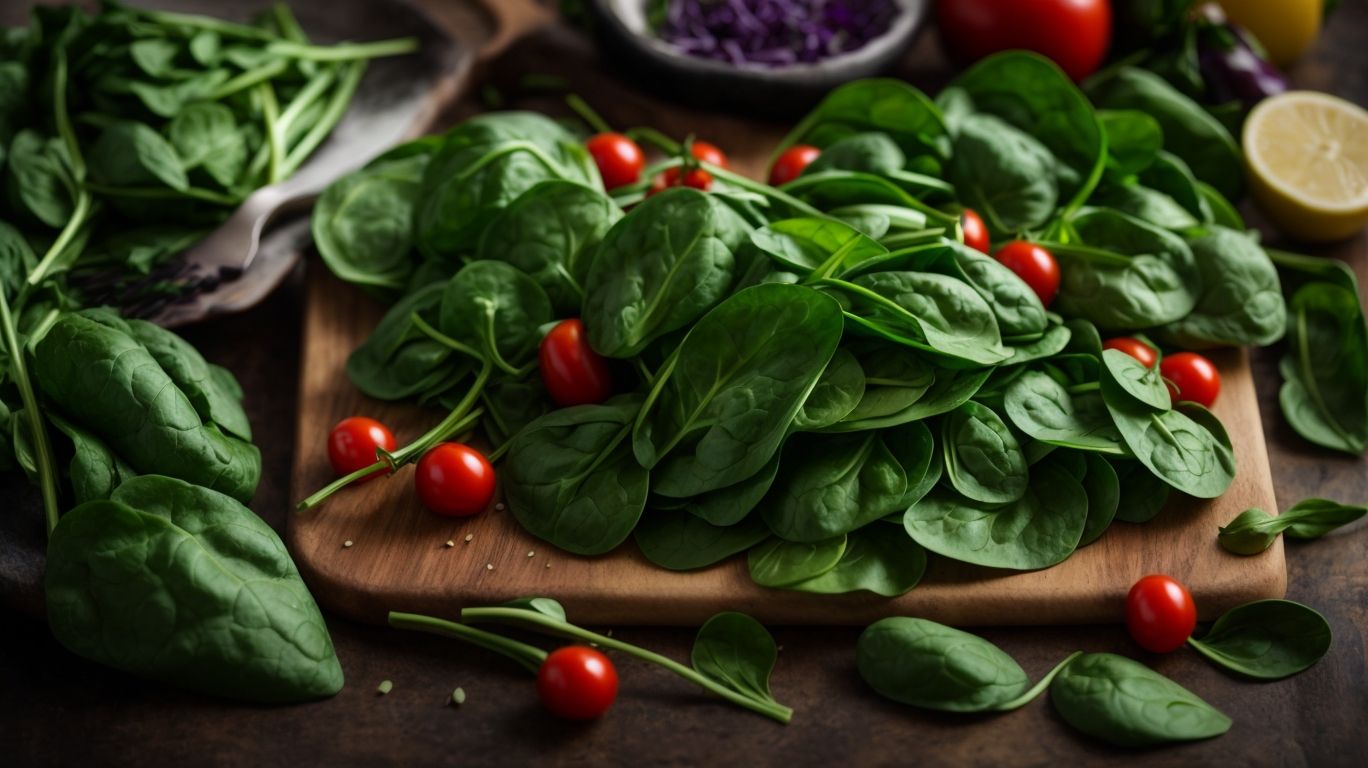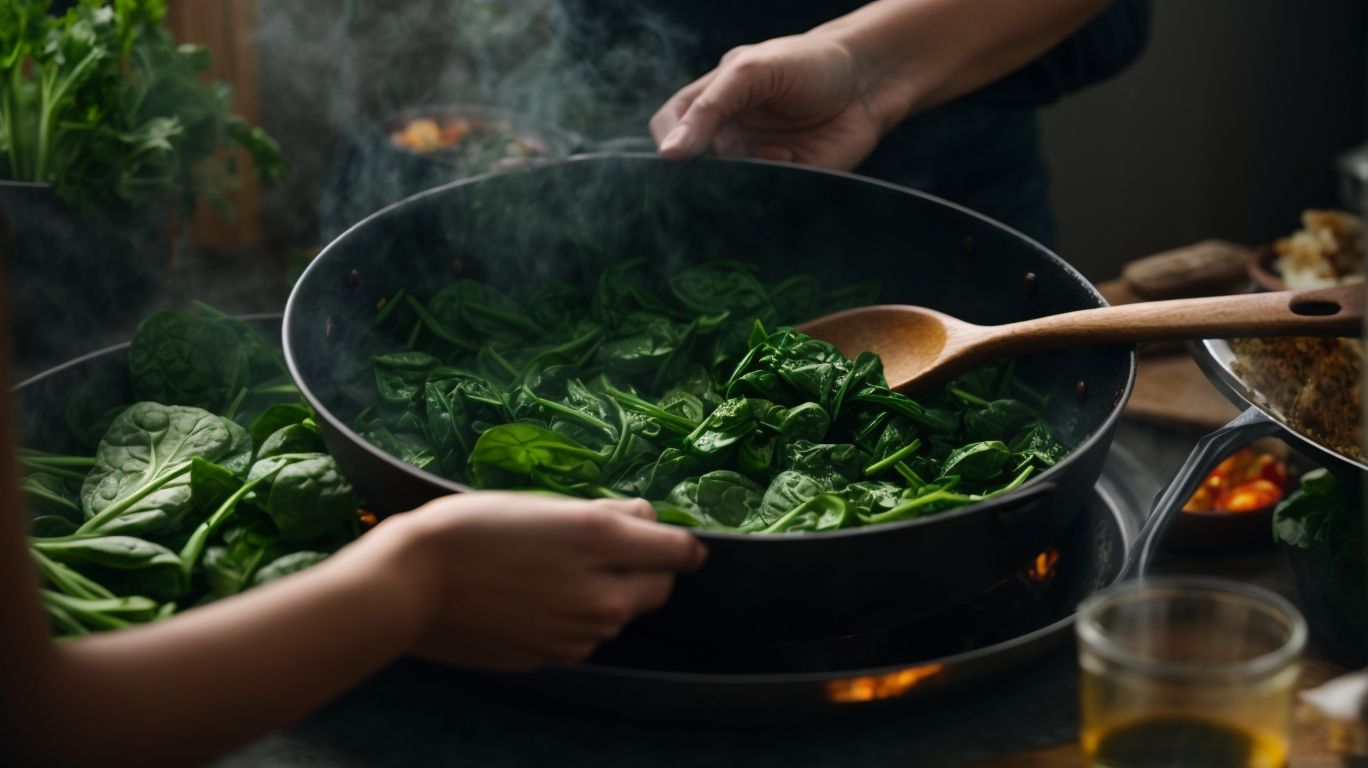How to Cook Spinach Without Losing Nutrients?
Spinach, with its abundance of nutrients, is a superfood that can enhance any dish. Cooking spinach can sometimes lead to the loss of these valuable nutrients.
We will explore tips from a professional chef on how to retain the nutrients in spinach while cooking. From the key nutrients found in spinach to common mistakes people make when cooking it, we will provide you with expert advice on the best cooking methods and how to incorporate this leafy green into your meals for maximum nutrient intake.
Let’s get cooking!
Key Takeaways:
Cooking Spinach to Retain Nutrients: Tips from a Professional Chef
Discover essential tips from a professional chef on cooking spinach to retain its valuable nutrients while enhancing its flavors and health benefits.
One crucial technique advised by chefs is to blanch spinach briefly before cooking to lock in its nutrients, following it with a plunge in ice-cold water to retain its vibrant green color. Sautéing spinach with a drizzle of olive oil and sprinkling of garlic powder can elevate its taste without compromising on health benefits. Incorporating spinach into flavorful dishes such as creamy spinach and parmesan pasta or a hearty spinach and feta stuffed chicken breast can further enhance its appeal and nutrient profile.
Why Is Spinach a Nutrient-Rich Superfood?

Credits: Poormet.Com – Albert Flores
Spinach stands out as a nutrient-rich superfood packed with essential vitamins, minerals, and antioxidants that offer numerous health benefits.
One of the key nutrients found abundantly in spinach is iron, which plays a crucial role in oxygen transport throughout the body. Spinach is a great source of vitamin K, important for bone health and blood clotting. This leafy green vegetable also contains high levels of antioxidants such as vitamin C and beta-carotene, which help protect the body from oxidative stress and reduce the risk of chronic diseases.
What Are the Key Nutrients Found in Spinach?
Spinach boasts a rich array of key nutrients, including vital vitamins, essential minerals, and notable iron content, making it a favorite of health enthusiasts like Popeye and experts like Jessica Cording and Samara Abbot.
One of the most crucial components of spinach’s nutritional profile is its high iron content, which plays a significant role in supporting overall health and wellness. Spinach is a powerhouse of vitamins such as vitamin A, vitamin C, and vitamin K, offering a range of benefits from immunity support to bone health. This leafy green vegetable is packed with essential minerals like potassium, magnesium, and calcium, contributing to various bodily functions and reinforcing its status as a superfood.
What Are the Common Mistakes When Cooking Spinach?
Avoiding common mistakes when cooking spinach is crucial to preserving its vitamins, minerals, and health benefits, while achieving optimal seasoning and flavor.
Overcooking spinach can lead to a significant loss of essential nutrients such as vitamin C, folate, and iron. The delicate leaves can quickly turn limp and lose their vibrant green color when exposed to high heat for prolonged periods.
To maintain spinach’s nutritional value, it is recommended to cook it quickly over medium heat or incorporate it raw into salads for maximum benefit. This leafy green vegetable boasts numerous health perks, including its high antioxidant content and anti-inflammatory properties.
Why Do People Overcook Spinach?
The tendency to overcook spinach often stems from a lack of awareness about the impact on nutrient loss and compromised health benefits, highlighting the importance of following proper cooking methods and instructions.
When spinach is subjected to prolonged cooking, such as boiling or continuous exposure to high heat, it can lead to a significant reduction in essential nutrients, including iron, vitamin C, and folate. These nutrients are vital for various bodily functions, and their depletion can diminish the health benefits that spinach offers. By following appropriate cooking techniques, such as steaming or quick sautéing, individuals can retain more of these valuable nutrients, enhancing the overall nutritional value of this leafy green vegetable.
Why Do People Use High Heat When Cooking Spinach?
The inclination to use high heat when cooking spinach can jeopardize its nutrient content, particularly vitamins crucial for health benefits, underscoring the significance of adopting alternative instructions and tips to maintain nutritional value.
When spinach is exposed to high temperatures for prolonged periods, there is a risk of breaking down sensitive nutrients such as Vitamin C and certain B-vitamins. These vitamins are essential for immune function, energy production, and overall wellbeing.
To preserve these vital nutrients, it is advisable to opt for cooking methods like:
- steaming
- sautéing at lower temperatures
- quick blanching
that help retain the nutritional integrity of spinach. Consuming raw spinach in salads or smoothies is an excellent way to benefit from its full nutrient profile without exposure to heat-induced degradation.
How to Cook Spinach Without Losing Nutrients?
Master the art of cooking spinach without compromising its valuable nutrients by utilizing specific techniques such as low heat, steam trapping with a lid, and the incorporation of acidic ingredients for enhanced flavor and health benefits.
When cooking spinach, maintaining its nutritional value is crucial for reaping its full benefits. Using low heat is essential to prevent excessive nutrient loss. By covering the pan with a lid during cooking, you can trap the steam, allowing the spinach to retain more of its vitamins and minerals.
Incorporating acidic components like a squeeze of lemon juice or a splash of vinegar not only enhances the taste but also helps preserve the nutrients within the spinach. This simple addition can elevate the flavor profile of the dish while ensuring that you get the most out of this incredibly nutrient-rich leafy green.
Use Low Heat
Employing low heat during the cooking process is vital to safeguarding the nutrients and vibrant green color of spinach, ensuring maximum health benefits and visual appeal.
When heat is applied gently and at a low setting, the delicate structure of spinach leaves is preserved, preventing the loss of essential vitamins like vitamin C and folate. This gentle cooking method minimizes nutrient degradation, allowing the body to fully absorb the nutritional goodness of spinach. The vibrant green hue of the spinach leaves remains intact, enhancing not only the dish’s presentation but also indicating the retention of its nutritional value.
Cook Spinach in Small Batches
Dividing the cooking process into small batches for spinach ensures better nutrient retention, especially vitamins essential for health benefits, following a methodical approach to optimize its culinary value.
By cooking spinach in smaller portions, you can prevent nutrient loss during the preparation process while keeping its health benefits intact.
This approach is particularly crucial for preserving delicate vitamins like Vitamin C and folate, which are known to be heat-sensitive and can degrade quickly when exposed to prolonged high heat.
To enhance the culinary value of spinach further, consider incorporating complementary flavors such as garlic, lemon zest, and herbs like nutmeg or thyme during cooking.
Use a Lid to Trap Steam
Utilizing a lid to trap steam while cooking spinach aids in retaining its nutrients and associated health benefits, allowing for optimal seasoning and flavor enhancement.
When the lid is placed on the cooking vessel, the steam generated from the spinach is efficiently captured, creating a humid environment within. This ensures that the delicate nutrients within the spinach are not lost during the cooking process, resulting in a healthier final dish. The trapped steam helps in intensifying the flavors of any added seasonings or spices, imparting a more vibrant and rich taste to the dish. Preservation of steam also contributes to a more tender and evenly cooked spinach, enhancing not just the nutritional profile but also the overall culinary experience.
Add Acidic Ingredients
Incorporating acidic ingredients when cooking spinach not only enhances its flavor profile but also aids in retaining valuable nutrients and health benefits, offering a vibrant and tangy culinary experience.
When a splash of lemon juice or a touch of balsamic vinegar meets the tender leaves of spinach, the natural brightness of the greens is accentuated, creating a harmonious balance of flavors.
The acidity in these ingredients acts as a flavor enhancer, elevating the overall taste profile of the dish while also contributing to the preservation of key nutrients such as vitamin C and iron present in spinach.
The acidic components can help break down some of the tougher fibers in spinach, making it easier to digest and absorb the essential nutrients the leafy green has to offer.
Use the Right Cooking Method
Selecting the appropriate cooking method for spinach is crucial to maintaining its nutrient content, vitamins, and health benefits, ensuring a delectable balance of seasoning and flavor intensification.
In terms of preparing this leafy green, spinach, the way it’s cooked can significantly impact its nutritional value and taste. Steaming is a popular choice as it helps to retain most of the vitamins and minerals, without sacrificing its vibrant color and flavor. Alternatively, stir-frying spinach with a touch of garlic can add depth and richness to the dish, enhancing its overall palatability. By carefully selecting your cooking method, you can unlock the full potential of spinach and enjoy a dish that is both nutritious and delicious.
What Are the Best Cooking Methods for Retaining Spinach’s Nutrients?

Credits: Poormet.Com – Logan Adams
Discover the most effective cooking methods for preserving the nutrients of spinach, ensuring the retention of essential vitamins, minerals, and health benefits through techniques like steaming, boiling, sautéing, and blending.
When looking to maximize the nutritional value of spinach, it’s crucial to understand how different cooking methods can impact its health benefits.
- Steaming spinach is often heralded as a top choice for retaining its nutrients, as this gentle cooking process helps lock in vitamins such as A, C, and K, along with minerals like iron and magnesium.
- Boiling spinach, while convenient, may lead to some loss of water-soluble vitamins.
- Sautéing, on the other hand, provides a delicious alternative that preserves the crunchiness of spinach while enhancing flavors with minimal nutrient loss.
- Blending spinach into smoothies or soups ensures a concentrated intake of nutrients in an easily digestible form.
Steaming
Steaming spinach is a recommended cooking method to preserve its nutrients, vitamins, and health benefits, resulting in a vibrant green appearance that signifies optimal culinary quality.
Steaming helps retain the water-soluble vitamins and minerals that might be otherwise lost through boiling. Maintaining the vibrant green color in spinach through steaming enhances its visual appeal on the plate, making it more appetizing and attractive to eat. This gentle cooking method also prevents excessive nutrient leaching, ensuring that you get the full spectrum of health benefits from your spinach dish. Steaming spinach allows for a quicker cooking process, preserving the delicate texture of the leaves and minimizing nutrient degradation.
Boiling
Boiling spinach in a controlled manner can help retain its nutrients, vitamins, and health benefits, utilizing techniques like draining in a colander and simmering to optimize culinary outcomes.
When you boil spinach under careful conditions, you protect the valuable vitamins and minerals that this leafy green powerhouse offers. By starting with fresh spinach and then appropriately draining it in a colander, you remove excess water that could dilute its nutrient content.
The next step is simmering the spinach just enough to maintain its vibrant color and nutritional profile. This method not only enhances flavor but also ensures you reap the maximum health benefits from this nutritious vegetable.
Sautéing
Sautéing spinach with precision maintains its nutrients, vitamins, and health benefits, elevating the dish with flavorful seasoning like garlic oil for a delectable culinary experience.
When sautéing spinach, the quick cooking method helps retain the vegetable’s natural flavors and nutritional value, making it a wholesome addition to any meal. The addition of garlic oil not only infuses a delightful taste but also brings in additional health benefits, as garlic is known for its antioxidant properties and immune-boosting effects. By sautéing spinach efficiently, you can enjoy a balanced dish that satisfies both your taste buds and your body’s need for essential nutrients.
Blending
Blending spinach in nutritious smoothies is a creative way to preserve its nutrients and health benefits, utilizing innovative tools like ice trays for convenient storage and consumption.
Spinach adds a powerhouse of vitamins and minerals without compromising the flavor of your smoothie, making it a coveted addition for health enthusiasts. By blending it with fruits like bananas and berries, you can create a delicious and vibrant drink that is packed with essential nutrients.
One practical tip is to freeze blended spinach mixtures in ice trays for easy portioning and quick additions to future smoothies. This method not only saves time but also ensures that the spinach retains its nutrients for longer durations.
How to Incorporate Spinach into Your Meals to Maximize Nutrient Intake?
Optimize your nutrient intake by seamlessly integrating spinach into your meals, whether through invigorating smoothies, vibrant salads, comforting soups, or flavorful stir-fries for a diverse and health-enhancing culinary experience.
Spinach is a powerhouse leafy green packed with essential nutrients like iron, calcium, and vitamins A and K. Incorporating spinach into your diet can bring a delightful burst of flavor and color to your plate, all while boosting your overall health and well-being. Whether you blend it into a refreshing smoothie with banana and almond milk, toss it into a colorful salad with strawberries and feta cheese, simmer it in a nourishing soup, or sauté it in a savory stir-fry, there are endless possibilities to enjoy this versatile and nutrient-rich vegetable.
Smoothies
Enrich your diet with nutrient-packed spinach smoothies that offer a delightful blend of flavors and health benefits, exploring recipes curated by experts like Bhavana Bhat for a rejuvenating culinary journey.
“
Spinach smoothies have gained popularity not only for their refreshing taste but also for their immense contribution to overall well-being. Incorporating this leafy green powerhouse into your daily routine can significantly boost your intake of essential nutrients like iron, calcium, and vitamins C and K.
- Pairing spinach with fruits like bananas, mangoes, or berries can add a natural sweetness while providing a rich source of antioxidants and fiber.
- Discovering innovative ways to infuse spinach into your smoothies opens a world of culinary possibilities, allowing you to experiment with ingredients like almond milk, chia seeds, or protein powder for added nutritional value.
Indulge in the vibrant array of colors and textures that spinach smoothies offer, making each sip not only a treat for your taste buds but also a boon for your health journey.
Salads
Elevate your culinary repertoire with vibrant spinach salads brimming with nutrients and health benefits, exploring innovative recipes crafted by experts such as Rhea Melwani for a refreshing and nourishing dining experience.
Spinach salads have long been celebrated for their powerhouse of nutritional content, boasting high levels of vitamins A, C, and K, as well as minerals like iron and magnesium.
- Delving into the world of spinach salads introduces a myriad of flavor combinations, from classic pairings like strawberries and feta to more unconventional additions like grilled peaches and toasted almonds.
- Platforms like Pinterest are treasure troves of inspiration, offering a plethora of visually appealing and easy-to-follow recipes from culinary enthusiasts worldwide, making it effortless to explore and experiment with different salad variations.
Soups
Warm up your palate with nourishing spinach soups rich in nutrients and health benefits, exploring a repertoire of recipes available on platforms like Pinterest for a comforting and flavorful culinary experience.
Spinach, renowned for its nutritional value, takes center stage in these delightful soups, providing a powerhouse of vitamins and minerals essential for well-being. The versatility of spinach lends itself well to soups, offering a vibrant green hue and earthy flavor that pairs harmoniously with various ingredients like creamy dairy products, aromatic herbs, and hearty grains.
Exploring recipes on digital platforms such as Pinterest can ignite your creativity in the kitchen, inspiring you to infuse unique flavors and textures into your spinach soups. From creamy purees to chunky broths, the possibilities are endless, allowing you to customize your soup to suit your preferences and dietary requirements.
Stir-fries
Embrace the culinary art of spinach stir-fries to savor nutrient-rich dishes with health benefits, exploring diverse recipes and cooking methods to create a symphony of flavors and nourishment in each bite.
Spinach, known for its rich nutrient profile and versatility, serves as a foundation for an array of tantalizing stir-fry dishes. Whether you opt for a classic spinach and garlic stir-fry or venture into more exotic combinations like sesame spinach stir-fry, the possibilities are endless. By adding succulent proteins like tofu or shrimp, you can elevate the nutritional value and create a balanced meal. From the crispy texture of flash-fried spinach to the subtle sweetness of oyster sauce-glazed varieties, each stir-fry presents a unique amalgamation of taste sensations.
Frequently Asked Questions
How to Cook Spinach Without Losing Nutrients?
What is the best way to cook spinach without losing nutrients?
The best way to cook spinach without losing nutrients is by steaming or sautéing it. These methods help to retain the most nutrients compared to boiling or microwaving.
How do I steam spinach without losing nutrients?
Do I need any special equipment to steam spinach?
No, you do not need any special equipment. Simply place a steamer basket or colander over a pot of boiling water and add your spinach. Cover and let it steam for a few minutes until wilted.
Can I sauté spinach without losing nutrients?
Is sautéing spinach a healthy cooking method?
Yes, sautéing spinach with a little bit of olive oil is a healthy cooking method that helps to retain nutrients. Just remember to not overcook it and keep the heat at a medium-high temperature.
How long should I cook spinach to retain its nutrients?
How can I ensure that my spinach is not overcooked?
It’s important to cook spinach for a short amount of time, usually no more than 3-5 minutes. This will help to retain its nutrients and prevent it from becoming mushy.
Is it okay to cook spinach in the microwave?
Can I cook spinach in the microwave without losing nutrients?
While it is possible to cook spinach in the microwave, it is not the best method for retaining nutrients. If you do choose to use the microwave, make sure to use a microwave-safe dish and only cook for a short amount of time.
What are some other ways to cook spinach without losing nutrients?
Are there any other cooking methods besides steaming and sautéing that retain nutrients?
Yes, you can also try blanching or stir-frying spinach to retain nutrients. Just make sure to not cook it for too long and avoid using high heat.




